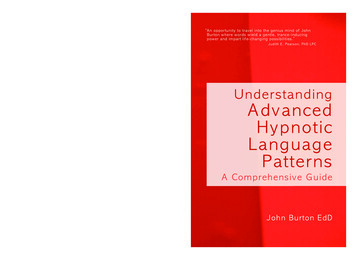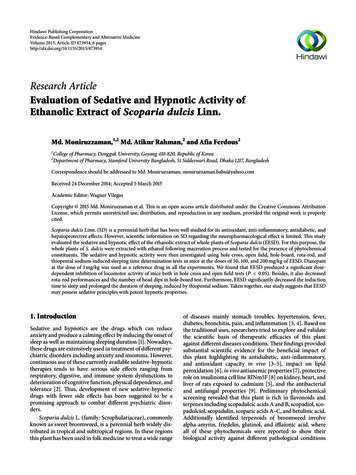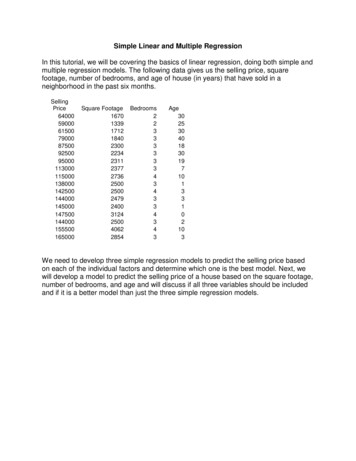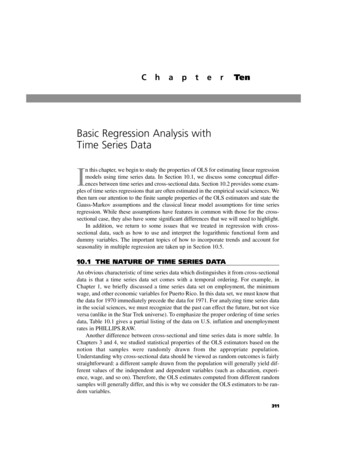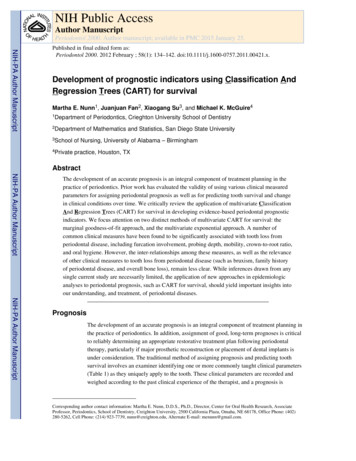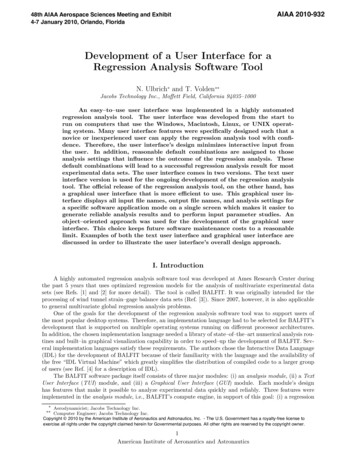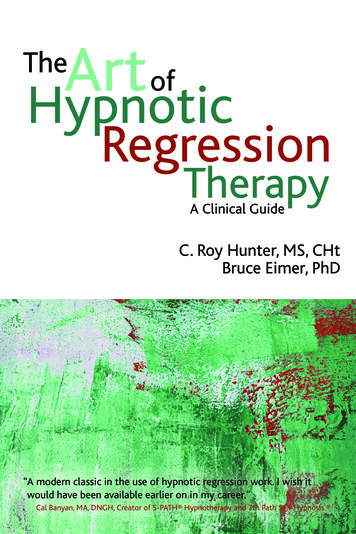
Transcription
ofArtHypnoticTheRegressionTherapyA Clinical GuideC. Roy Hunter, MS, CHtBruce Eimer, PhD“ A modern classic in the use of hypnotic regression work. I wish itwould have been available earlier on in my career.”Cal Banyan, MA, DNGH, Creator of 5-PATH Hypnotherapy and 7th Path Self-Hypnosis
Praise for The Art of Hypnotic Regression TherapyA basic theme for hypnoanalysis is that the client knows what theyneed, but needs coaching to find it and correct it. Looking beyond acti vating events or subsequent sensitizing events leads one to the rootcause or initial sensitizing events and hence treatment. The psycho somatic problem-solving is artfully described and adjudicated throughRoy Hunter’s multiple case examples and Bruce Eimer’s PTSD andpain patients. Through the techniques that are described in this text,Drs. Hunter and Eimer create and activate the art of hypnosis andcouple this with an excellent review of various psychotherapy tech niques employed.Hypnoanalysis is truly more art than science and with the strokesof the pen this solid book teaches us to open a new canvas on whichthose trained in hypnosis arts can paint.Joseph F Zastrow MD FAAFPASCH President 2012If you are a therapist reluctant to use regression then read this bookas it will encourage you to confidently return to a powerful and mis understood technique. If you are an experienced regression therapistwondering whether to read this book, do so as it has the potential toopen up your perspectives and teach you plenty more.Peter Mabbutt, CEO/Director of Studies,London College of Clinical HypnosisIt is informative, well written with a systematic approach that showsus that, by following the guidelines in this book, Hypnotic RegressionTherapy can be a very powerful tool that can be safely used.Bruni Brewin, President Emeritus,Australian Hypnotherapists’ AssociationAHRT.indd 107/06/2012 15:35:12
All clinicians using hypnosis are encouraged to read this work whetheras an aide to manage unanticipated spontaneous regressions or as aready reference for intentionally planned therapy. One’s knowledge ofclinical hypnosis is incomplete without the foundation of HRT thatthe authors impart.Dr. Gabor Filo DDS, DABHD, FASCH,FPFATwo of hypnotherapy’s stellar practitioners, Roy Hunter and BruceEimer, have pooled their expertise to produce a book on regressionhypnotherapy so comprehensive, it is the only guide to regressionhypnosis a hypnotherapist will ever need.Judith E. Pearson, Ph.D., L.P.C., Hypnotherapist andNLP Trainer, Motivational Strategies, Inc., Springfield, VirginiaAs a hypnoanalyst for many years, I can vouch for the fact that thiswonderful book contains every bit of information needed to use regres sion therapy successfully. Scripts, techniques, “how-to” examples andcase studies, along with a defined structure for the therapy, make thisthe ideal read for the newcomer to regression work, as well as havingmuch of worth to those more experienced. Authors Roy Hunter andBruce Eimer are experienced and accomplished professional therapists– and it shows.Terence Watts, MCGI, Fellow of the Royal Society of MedicineThis book, meticulous in writing and obviously close to the authors’hearts is an outstanding credit to them. They have shared generouslytheir wealth of knowledge and their belief in HRT shines through.Enjoy and learn.Tom Barber DHp, MA, Director ofContemporary College of Therapeutic Studies, UKCo-author of Thinking Therapeutically:Hypnotic Skills & Strategies Explored.AHRT.indd 207/06/2012 15:35:12
I recommend this book to all serious students and practitioners ofHypnotic Regression Therapy, and I wish it had been available earlier onin my career as a hypnosis professional. It is an excellent way to makethe leap from working as a script bound, direct suggestion hypnotist ,to one of being a powerful change maker who can get results whenother lesser forms of hypnotherapy have failed.Cal Banyan, MA, DNGHCreator of 5-PATH Hypnotherapy and 7th Path Self-Hypnosis Age regression is a very complex subject. The authors have made iteasy to understand by all practitioners of hypnotherapy regardless ofthe level of their experience and knowledge.A. Max Chaumette, Jr., M.D., ABA, ABMHNote: Full reviews from all these professionals can be viewed on theCrown House website www.crownhouse.co.ukAHRT.indd 307/06/2012 15:35:12
The Art ofHypnoticRegressionTherapyAHRT.indd 107/06/2012 15:35:12
The Art ofHypnoticRegressionTherapyA Clinical GuideC. Roy Hunter, MS, CHtBruce N. Eimer, PhD, ABPPAHRT.indd 307/06/2012 15:35:13
First published byCrown House Publishing LtdCrown Buildings, Bancyfelin, Carmarthen, Wales, SA33 5ND, UKwww.crownhouse.co.ukandCrown House Publishing Company LLC6 Trowbridge Drive, Suite 5, Bethel, CT 06801-2858, USAwww.crownhousepublishing.com C. Roy Hunter and Bruce N. Eimer, 2012The right of C. Roy Hunter and Bruce N. Eimer to be identified as the authors ofthis work has been asserted by them in accordance with the Copyright, Designs andPatents Act 1988.First printed 2012All rights reserved. Except as permitted under current legislation, no part of this work may bephotocopied, stored in a retrieval system, published, performed in public, adapted, broadcast,transmitted, recorded or reproduced in any form or by any means, without the prior permissionof the copyright owner. Enquiries should be addressed to Crown House Publishing Limited.British Library Cataloguing-in-Publication DataA catalogue entry for this book is available from the British Library.ISBNISBN 978-184590851-5 (print)ISBN 978-184590852-2 (mobi)ISBN 978-184590853-9 (ePub)LCCN 2012937015Printed and bound in the USACrown House Publishing has no responsibility for the persistence or accuracy of URLs forexternal or third-party websites referred to in this publication, and does not guarantee that anycontent on such websites is, or will remain, accurate or appropriate.AHRT.indd 407/06/2012 15:35:13
AcknowledgementsI, Roy Hunter, wish to first express my deepest gratitude for my latementor and friend, Charles Tebbetts, who taught me the basics of cli ent centered hypnotherapy and regression therapy. Additionally, as Dr.Eimer stated, it takes many people to bring a book like this into print,so I echo his gratitude and praise for all the people at Crown HousePublishing who have worked with both of us. Also, I appreciate my wife,Jo-Anne, for her patience during the many late nights I spent writingand revising my contributions to the book. Last but not least, I wishto thank both the hypnosis professionals and hypnotherapy instructorsaround the world who believe in my work enough to purchase my otherbooks, as well as my clients over the years whose successful results vali date the benefits of the client centered approach to hypnotherapy.C. Roy HunterBringing a book like this to fruition demands the help of many people.First, we gratefully acknowledge the expert help, patient assistance,and continual support of our editors at Crown House, Mark Tracten,Rosalie Williams and Beverley Randell, who made this project possible.We gratefully acknowledge David Bowman of Crown House for seeingthe value in this book.I gratefully acknowledge my two mentors in hypnoanalysis andhypnotic regression work, Dabney Ewin, MD and the late David Cheek,MD. Dr. Ewin has been a good friend and mentor for over 20 years.I also thank my mentor and good friend, Jordan Zarren, LCSW, foris friendship and all of the mentoring in hypnotherapy he has pro vided me over the years. I thank my wife, Andrea, and my daughters,Marisa and Allison, for loving and standing by me over the years, andmy mother Cecile Eimer for being there for me my entire life. Last butnot least, I thank all of the patients who have shared their life storieswith me over the years.Bruce N. EimerviiAHRT.indd 707/06/2012 15:35:13
ForewordHypnosis is a level of focus that allows the person experiencing it tobecome almost completely unaware of the multiple other things thatmight otherwise flit in and out of mind. The person in deep tears overa lost love is experiencing hypnosis, as is the person who has unin tentionally clicked off into a daydream state during a boring talk. NoOlympic weightlifter would lift a weight in competition without beingin a state of hypnosis. The mind of the weightlifter is singly focusedon lifting the weight, without thoughts of, “I hope my parking meterhas enough change in it,” or “On my way back I need to pick up somebread.”Hypnosis is a natural state that we all enter spontaneously, and, initself other than providing some time of focused retreat, it has no spe cial healing properties. But, in the hands of a professional hypnothera pist that hypnotic state of single minded focus can facilitate more rapidwanted change. Hypnosis can also be used by the well trained therapistto gain access to parts that hold unresolved issues; unresolved issuesthat sometimes bring forth feelings of fear or rejection. That is whatthis book is about.This is a book written by two skilled professionals who share meth ods to gain access to personality parts that need resolution. Thingshappen in our past that can continue to affect us in our present. Thatis the central tenet of psychodynamic psychotherapy. It was Freud’sunderstanding of this basic concept that allowed him to become widelyknown as the father of psychotherapy. Freud saw in his patients a con nection between past traumas and the current feelings of being out ofcontrol, and he was correct in this vision. What he lacked was an ele gant and streamlined therapeutic mechanism to relieve the trauma ofthe past so it would no longer interfere in the present. His psychoanal ysis was lengthy, relied on interpretations of analysts, and too oftenproved to be ineffective. Still his work spawned other attempts bypsychodynamic therapists such as Jung and Adler to assist patients toixAHRT.indd 907/06/2012 15:35:13
Forewordgain relief from the traumas of their past. These therapies lacked a wayto bring forth the parts of the personality (that held onto trauma) sothese personality parts could get the needed assistance to gain relief.The next big movement in psychotherapy was the humanist phe nomenological movement. Person Centered, Gestalt and ExistentialTherapies were an attempt to assist personality parts to gain healingby being able to be heard and understood. Indeed the word, Gestalt,means whole and it was the purpose of the therapy process to bringout parts that kept the personality from being whole. By encouragingclients to talk about the phenomena that had been difficult or con fusing it was assumed that they would gain resolution and then thewhole personality could be functional. These therapies lacked both atheoretical understanding of the parts of the personality and regres sion techniques to assist the therapist to quickly and precisely get tothe core of the problem. Too often the wrong part would be the talkingpart, and only truly gifted therapists could assist clients to speak fromthe parts that carried fear or rejection and speak to them in a way thatbrought resolution.The current major movement in psychotherapy is CBT. The cognitivebehavioural movement is a reflection of the symptom-based medicalmovement. The symptom, not the cause of psychological distress isthe focus in this movement. CBT therapists are trained that the pastis past and there is no benefit in spending time there. They are trainedto work with clients to change the way they think about issues, and togive clients homework so they can practice functioning in a differentway. A traumatised part of the personality is not accessed and is nothealed. It is left with its trauma while surface parts are taught newways of thinking and new ways of acting. The proverbial bullet is leftin the wound, so complete, cathartic healing cannot be experienced.These CBT techniques can help clients better deal with life issues andcan help clients get through tough times, but they do not facilitatedeeper change. The part that feels afraid or rejected continues to holdthese feelings. If a fun loving and playful part of the personality experi ences an incident where fear or rejection overwhelms this state and ifxAHRT.indd 1007/06/2012 15:35:13
Forewordthere is no real level of conversation and understanding afterword thatstate can become Vaded (a state overwhelmed by chronic negative feel ings). This Vaded state may come to the surface at any time resultingin the person re-experiencing these same negative feelings of fear orrejection. The techniques presented in this book facilitate the thera pist to bring out this Vaded state with regression techniques and helpthis state heal, thus eliminating the root cause of the negative feelings.The symptoms will automatically change because the previously Vadedstate has been assisted to a state of normality. A real benefit of thistype of intervention is that this state will again be free to resume itsoriginal role of being fun loving and playful. The client will feel morefree, and will no longer carry those negative ‘out of control’ feelings.When a situation arises that would have previously brought out thenegative feelings of fear or rejection not only will those feelings notcome to the surface, but the client will be able to handle the situationusing preferred personal resources.Another benefit in using the types of techniques presented in thisbook is that they are very quick. It takes more time to train a client inmethods of how to think about and deal with an unwanted symptomthan it does to directly go to the cause and resolve it. Some therapistsuse hypnosis to merely focus on the symptom. Often hypnotherapyis thought of as a way to suggest that things will be different, andbecause of the power of hypnosis it is often thought that things will bedifferent merely because the suggestion was made. Attempting to usehypnosis it this way is like using a smart phone to hammer in a nail.It might work a little,
Hypnosis is a level of focus that allows the person experiencing it to become almost completely unaware of the multiple other things that might otherwise flit in and out of mind. The person in deep tears over a lost love is experiencing hypnosis, as is the person who has unin tentionally clicked off into a daydream state during a boring talk. No

